Time-Dependent Adhesion and Fluoride Release of Resin-Modified Glass Ionomer Cements on Demineralized Enamel, Sound Enamel and Dentine
Abstract
1. Introduction
2. Materials and Methods
2.1. Samples
2.2. Shear Force Resistance Test (RFC)
2.3. Types of Fractures
2.4. Field Emission Scanning Electron Microscopy
2.5. Fluoride Release
2.5.1. Cumulative Fluoride Release Rate
2.5.2. Daily Fluoride Release Rate
2.5.3. Measurement of Fluoride Ion
2.6. Statistical Analysis
3. Results
3.1. Resistance to Shear Forces
3.1.1. Analysis at 24 h (Table S3 in Supplementary Materials)
3.1.2. One-Month Analysis (Table S3 in Supplementary Materials)
3.1.3. Three-Month Analysis (Table S3 in Supplementary Materials)
3.1.4. Factorial Analysis
- Substrate vs. Time
- b.
- Substrate vs. Material
- c.
- Time vs. Material
3.2. Types of Fractures
3.3. Field Emission Scanning Electron Microscopy
3.4. Fluoride Release Analysis
- Cumulative Fluoride Release Rate
- b.
- Daily Fluoride Release Rate
4. Discussion
4.1. Discussion of the Method
4.2. Discussion of the Results
5. Conclusions
Supplementary Materials
Author Contributions
Funding
Institutional Review Board Statement
Informed Consent Statement
Data Availability Statement
Conflicts of Interest
Abbreviations
| MID | Minimally invasive dentistry |
| RMGICs | Resin-modified glass ionomer cements |
| SBS | Shear bond strength |
| FESEM | Field emission scanning electron microscopy |
| IMO | Minimally invasive dentistry |
| CRCs | Composite resins |
| RFC | Shear force resistance test |
| MPa | Megapascals |
References
- Jain, N.; Dutt, U.; Radenkov, I.; Jain, S. WHO’s Global Oral Health Status Report 2022: Actions, Discussion and Implementation. Oral Dis. 2024, 30, 73–79. [Google Scholar] [CrossRef]
- Schwendicke, F.; Splieth, C.; Breschi, L.; Banerjee, A.; Fontana, M.; Paris, S.; Burrow, M.F.; Crombie, F.; Page, L.F.; Gatón-Hernández, P.; et al. When to Intervene in the Caries Process? An Expert Delphi Consensus Statement. Clin. Oral Investig. 2019, 23, 3691–3703. [Google Scholar] [CrossRef]
- Cury, J.A.; Ricomini-Filho, A.P.; Tabchoury, C.P.M. Physicochemical Interactions between Enamel and Oral Fluids. Monogr. Oral Sci. 2023, 31, 50–61. [Google Scholar] [PubMed]
- Leme, A.F.P.; Koo, H.; Bellato, C.M.; Bedi, G.; Cury, J.A. The Role of Sucrose in Cariogenic Dental Biofilm Formation—New Insight. J. Dent. Res. 2006, 85, 878–887. [Google Scholar] [CrossRef] [PubMed]
- Murdoch-Kinch, C.A.; McLean, M.E. Minimally Invasive Dentistry. J. Am. Dent. Assoc. 2003, 134, 87–95. [Google Scholar] [CrossRef] [PubMed]
- Ngo, H.; Opsahl-Vital, S. Minimal Intervention Dentistry II: Part 7. Minimal Intervention in Cariology: The Role of Glass-Ionomer Cements in the Preservation of Tooth Structures against Caries. Br. Dent. J. 2014, 216, 561–565. [Google Scholar] [CrossRef]
- Ortiz-Ruiz, A.J.; Pérez-Guzmán, N.; Rubio-Aparicio, M.; Sánchez-Meca, J. Success Rate of Proximal Tooth-Colored Direct Restorations in Primary Teeth at 24 Months: A Meta-Analysis. Sci. Rep. 2020, 10, 6409. [Google Scholar] [CrossRef]
- Yengopal, V.; Mickenautsch, S. Caries-Preventive Effect of Resin-Modified Glass-Ionomer Cement (RM-GIC) versus Composite Resin: A Quantitative Systematic Review. Eur. Arch. Paediatr. Dent. 2011, 12, 5–14. [Google Scholar]
- Glasspoole, E.A.; Erickson, R.L.; Davidson, C.L. Effect of Surface Treatments on the Bond Strength of Glass Ionomers to Enamel. Dent. Mater. 2002, 18, 454–462. [Google Scholar] [CrossRef]
- Mauro, S.J.; Sundfeld, R.H.; Brendan-Russo, A.K.B.; Braga Briso, A.L.F. Strength of Adhesion of the Modified Glass Ion by Resin to Dentine: The Effect of the Treatment of the Dentinal Surface. J. Minim. Interv. Dent. 2009, 2, 215–223. [Google Scholar]
- Khoroushi, M.; Hosseini-Shirazi, M.; Soleimani, H. Effect of Acid Pre-Conditioning and/or Delayed Light Irradiation on Enamel Bond Strength of Three Resin-Modified Glass Ionomers. Dent. Res. J. 2013, 10, 328. [Google Scholar]
- Manso, A.P.; Chander, K.; Campbell, K.M.; Palma-Dibb, R.G.; Carvalho, R.M. Effects of Aging on Shear Bond Strength to Dentin and Mechanical Properties of Restorative Glass Ionomer Cements. Int. J. Adhes. Adhes. 2020, 102, 102693. [Google Scholar] [CrossRef]
- Kosior, P.; Klimas, S.; Nikodem, A.; Wolicka, J.; Diakowska, D.; Watras, A.; Wiglusz, R.J.; Dobrzyński, M. An in Vitro Examination of Fluoride Ions Release from Selected Materials—Resin-Modified Glass-Ionomer Cement (Vitremer) and Nanohybrid Composite Material (Tetric EvoCeram). Acta Bioeng. Biomech. 2023, 25, 101–115. [Google Scholar] [CrossRef]
- Van Meerbeek, B.; Peumans, M.; Poitevin, A.; Mine, A.; Van Ende, A.; Neves, A.; De Munck, J. Relationship between Bond-Strength Tests and Clinical Outcomes. Dent. Mater. 2010, 26, e100–e121. [Google Scholar] [CrossRef] [PubMed]
- Francois, P.; Vennat, E.; Le Goff, S.; Ruscassier, N.; Attal, J.-P.; Dursun, E. Shear Bond Strength; Interface Analysis between a Resin Composite and a Recent High-Viscous Glass Ionomer Cement Bonded with Various Adhesive Systems. Clin. Oral Investig. 2019, 23, 2599–2608. [Google Scholar] [CrossRef]
- Young, D.A.; Featherstone, J.D. Caries management by risk assessment. Community Dent. Oral Epidemiol. 2013, 41, e53–e63. [Google Scholar] [PubMed]
- Vicente, A.; Ortiz Ruiz, A.J.; González Paz, B.M.; García López, J.; Bravo-González, L.-A. Efficacy of Fluoride Varnishes for Preventing Enamel Demineralization after Interproximal Enamel Reduction: Qualitative and Quantitative Evaluation. PLoS ONE 2017, 12, e0176389. [Google Scholar] [CrossRef] [PubMed]
- Burke, F.J.T.; Shortall, A.C.C.; Combe, E.C.; Aitchison, T.C. Assessing Restorative Dental Materials: 1. Test Methods and Assessment of Results. Dent. Update 2002, 29, 188–194. [Google Scholar]
- Nakamichi, I.; Iwaku, M.; Fusayama, T. Bovine Teeth as Possible Substitutes in the Adhesion Test. J. Dent. Res. 1983, 62, 1076–1081. [Google Scholar] [CrossRef]
- Oesterle, L.J.; Shellhart, W.C.; Belanger, G.K. The Use of Bovine Enamel in Bonding Studies. Am. J. Orthod. Dentofac. Orthop. 1998, 114, 514–519. [Google Scholar] [CrossRef]
- Ortiz-Ruiz, A.J.; Teruel-Fernández, J.D.D.; Alcolea-Rubio, L.A.; Hernández-Fernández, A.; Martínez-Beneyto, Y.; Gispert-Guirado, F. Structural Differences in Enamel and Dentin in Human, Bovine, Porcine, and Ovine Teeth. Ann. Anat. 2018, 218, 7–17. [Google Scholar] [CrossRef]
- Leloup, G.; D’Hoore, W.; Bouter, D.; Degrange, M.; Vreven, J. Meta-Analytical Review of Factors Involved in Dentin Adherence. J. Dent. Res. 2001, 80, 1605–1614. [Google Scholar] [CrossRef]
- Krifka, S.; Börzsönyi, A.; Koch, A.; Hiller, K.-A.; Schmalz, G.; Friedl, K.-H. Bond Strength of Adhesive Systems to Dentin and Enamel—Human vs. Bovine Primary Teeth In Vitro. Dent. Mater. 2008, 24, 888–894. [Google Scholar] [CrossRef]
- Solanki, Y.S.; Agarwal, M.; Gupta, A.B.; Gupta, S.; Shukla, P. Fluoride Occurrences, Health Problems, Detection, and Remediation Methods for Drinking Water: A Comprehensive Review. Sci. Total Environ. 2022, 807, 150601. [Google Scholar] [CrossRef]
- Dhillon, A.; Nair, M.; Kumar, D. Analytical Methods for Determination; Sensing of Fluoride in Biotic and Abiotic Sources: A Review. Anal. Methods 2016, 8, 5338–5352. [Google Scholar] [CrossRef]
- Fritz, U.B.; Finger, W.J.; Uno, S. Resin-Modified Glass Ionomer Cements: Bonding to Enamel and Dentin. Dent. Mater. 1996, 12, 161–166. [Google Scholar] [CrossRef] [PubMed]
- Swift, E.J.; Pawlus, M.A.; Vargas, M.A. Shear Bond Strengths of Resin-Modified Glass-Ionomer Restorative Materials. Oper. Dent. 1995, 20, 138. [Google Scholar] [PubMed]
- Lawson, N.; Cakir, D.; Beck, P.; Ramp, L.; Burgess, J. Effect of Light Activation on Resin-Modified Glass Ionomer Shear Bond Strength. Oper. Dent. 2012, 37, 380–385. [Google Scholar] [CrossRef]
- Imbery, T.; Namboodiri, A.; Duncan, A.; Amos, R.; Best, A.; Moon, P. Evaluating Dentin Surface Treatments for Resin-Modified Glass Ionomer Restorative Materials. Oper. Dent. 2013, 38, 429–438. [Google Scholar] [CrossRef] [PubMed]
- Mendonça, B.C.; Rueggeberg, F.; Braga, R.R.; Soto, J.; Sebold, M.; Ambrosano, G.M.B.; Giannini, M. Physical and Adhesion Properties of Bulk-Fill Composites. Dent. Mater. 2018, 34, e33–e34. [Google Scholar] [CrossRef]
- Poorzandpoush, K.; Shahrabi, M.; Heidari, A.; Sadat Hosseinipour, Z. Shear Bond Strength of Self-Adhesive Flowable Composite, Conventional Flowable Composite and Resin-Modified Glass Ionomer Cement to Primary Dentin. Front. Dent. 2019, 16, 62. [Google Scholar] [CrossRef]
- Malekhoseini, Z.; Rezvani, M.B.; Niakan, M.; Atai, M.; Bassir, M.M.; Alizade, H.S.; Siabani, S. Effect of Zinc Oxide Nanoparticles on Physical and Antimicrobial. Dent. Res. J. 2021, 18, 73. [Google Scholar] [CrossRef]
- Sainath Reddy, T.; Venkatesh, K.V.; Mani, R. Comparative Evaluation of Three Different Glass Ionomer Cements. Indian J. Dent. Res. 2021, 32, 485. [Google Scholar] [CrossRef]
- Ortiz-Ruiz, A.J.; Martínez Marco, F.J.; Pérez Silva, A.; Serna Muñoz, C.; Cabello, I.; Banerjee, A. Influence of Fluoride Varnish Application on Enamel Adhesion of a Universal Adhesive. J. Adhes. Dent. 2021, 23, 47–56. [Google Scholar]
- Wiegand, A.; Buchalla, W.; Attin, T. Review on Fluoride-Releasing Restorative Materials—Fluoride Release and Uptake Characteristics, Antibacterial Activity and Influence on Caries Formation. Dent. Mater. 2007, 23, 343–362. [Google Scholar] [CrossRef]
- Phonghanyudh, A.; Theerareungchaisri, C.; Jirarattanasopa, V. Clinical evaluation of class II high-viscosity glass ionomer cement and composite resin restorations in primary molars: One-year result. Mahidol Dent. J. 2014, 34, 129–136. [Google Scholar]
- Tam, L.E.; Dev, S.; Pilliar, R.M. Fracture toughness of conventional or photopolymerized glass ionomer/dentin interfaces. Oper. Dent. 1995, 20, 144. [Google Scholar]
- Da Silva Telles, P.D.; Machado, M.A.A.M.; Nor, J.E. SEM Study of a Self-Etching Primer Adhesive System Used for Dentin Bonding in Primary and Permanent Teeth. Pediatr. Dent. 2001, 23, 315–320. [Google Scholar]
- Nijhawan, C.; Jasuja, P.; Sharma, A.; Khurana, H.; Gakhar, E. Comparative evaluation of shear bond strength of a traditional composite and ACTIVA BioACTIVE after enamel preparation with Er:YAG laser and conventional acid etching: An in vitro study. J. Dent. Lasers 2019, 13, 44. [Google Scholar] [CrossRef]
- Michou, S.; Larsen, L.; Benetti, A.R.; Peutzfeldt, A. Adhesion and marginal integrity of bioactive restorative materials. Dent. Mater. 2018, 34, e11. [Google Scholar] [CrossRef]
- Nanavati, K.; Katge, F.; Chimata, V.; Pradhan, D.; Kamble, A.; Patil, D. Comparative Evaluation of Shear Bond Strength of Bioactive Restorative Material, Zirconia Reinforced Glass Ionomer Cement and Conventional Glass Ionomer Cement to the Dentinal Surface of Primary Molars: An in vitro Study. J. Dent. 2021, 22, 260–266. [Google Scholar] [CrossRef]
- Bhatia, K. Comparative evaluation of a bioactive restorative material with resin modified glass ionomer for calcium-ion release and shear bond strength to dentin of primary teeth—An in vitro study. J. Clin. Pediatr. Dent. 2022, 46, 25. [Google Scholar] [CrossRef]
- Bordin-Aykroyd, S.; Sefton, J.; Davies, E.H. In vitro bond strengths of three current dentin adhesives to primary and permanent teeth. Dent. Mater. 1992, 8, 74–78. [Google Scholar] [CrossRef] [PubMed]
- Chowdhary, N.; Subba Reddy, V.V. Dentin comparison in primary and permanent molars under transmitted and polarised light microscopy: An in vitro study. J. Indian Soc. Pedod. Prev. Dent. 2010, 28, 167. [Google Scholar] [CrossRef]
- Harahap, K.I.; Rahmi, H.; Winni, M. Effect of Hydroxyapatite Synthesized from Tilapia Fish Scale Waste on the Shear Bond Strength of GIC and RMGIC to Enamel Layer (In Vitro Study). Mater. Sci. Forum. 2022, 1069, 135–143. [Google Scholar] [CrossRef]
- Rezvani, M.B.; Atai, M.; Safar Alizade, H.; Mohammadi Basir, M.; Koohpeima, F.; Siabani, S. The Effect of Incorporation of 0.5 %wt. Silica Nanoparticles on the Micro Shear Bond Strength of a Resin Modified Glass Ionomer Cement. J. Dent. 2019, 20, 124–130. [Google Scholar] [CrossRef]
- Forouzanmehr, M.; Barekatain, M.; Shahtalebi, M.A. An in vitro evaluation of the compressive strength and shear bond strength of resin-modified glass-ionomer cement containing purified powder of Salvia officinalis. Dent Res. J. 2020, 17, 319–325. [Google Scholar] [CrossRef]
- Moradian, M.; Jafarpour, D.; Saadat, M.; Tahmasebi, F. The effect of bacterial cellulose nanocrystals on the shear bond strength of resin modified glass ionomer cement to dentin. J. Clin. Exp. Dent. 2021, 13, e784–e788. [Google Scholar] [CrossRef]
- Vicente, A.; Rodríguez-Lozano, F.J.; Martínez-Beneyto, Y.; Jaimez, M.; Guerrero-Gironés, J.; Ortiz-Ruiz, A.J. Biophysical and Fluoride Release Properties of a Resin-Modified Glass Ionomer Cement Enriched with Bioactive Glasses. Symmetry 2021, 13, 494. [Google Scholar] [CrossRef]
- Panpisut, P.; Toneluck, A. Monomer Conversion, Dimensional Stability, Biaxial Flexural Strength, and Fluoride Release of Resin-Based Restorative Material Containing Alkaline Fillers. Dent. Mater. J. 2020, 39, 608–615. [Google Scholar] [CrossRef]
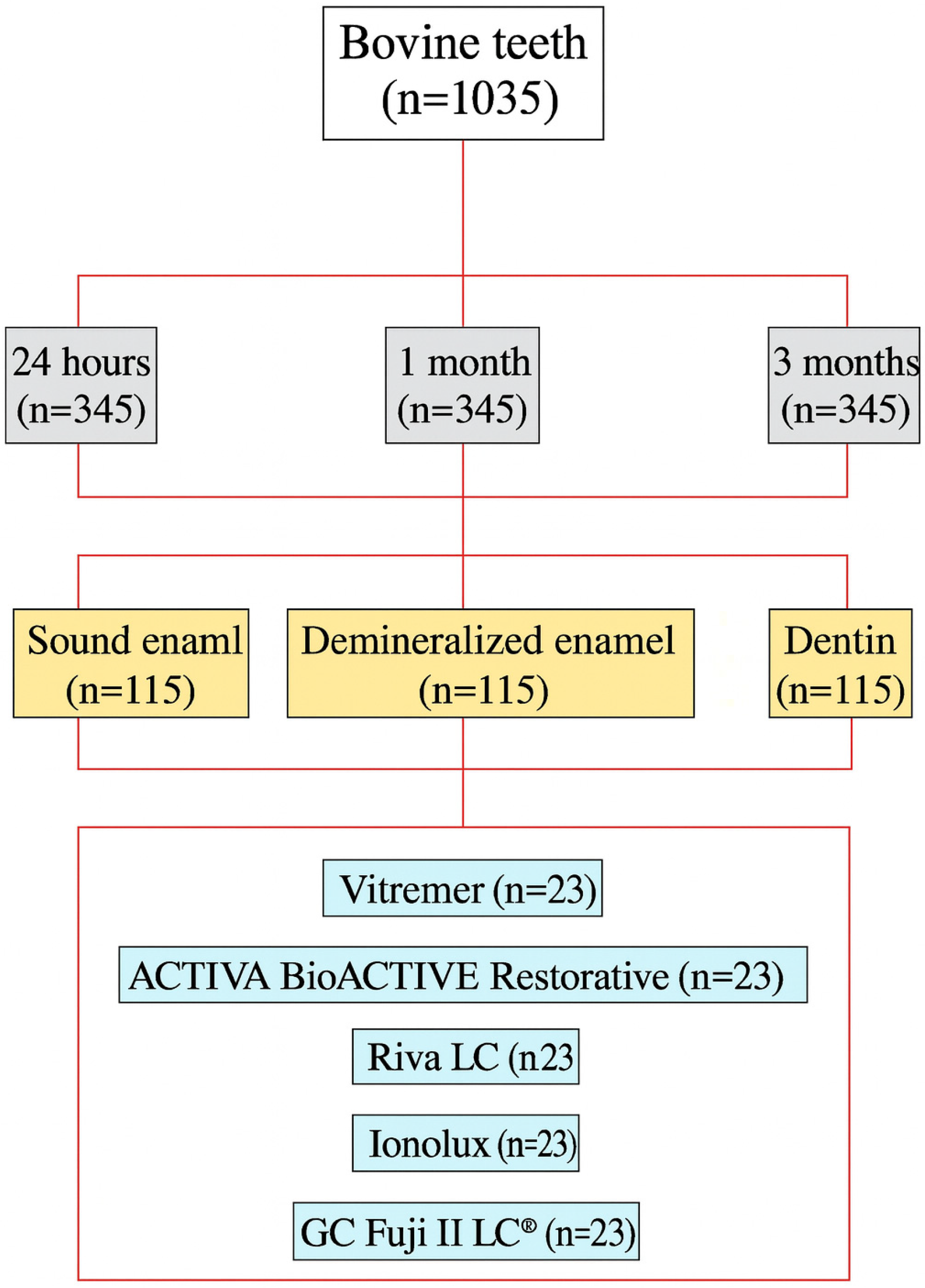
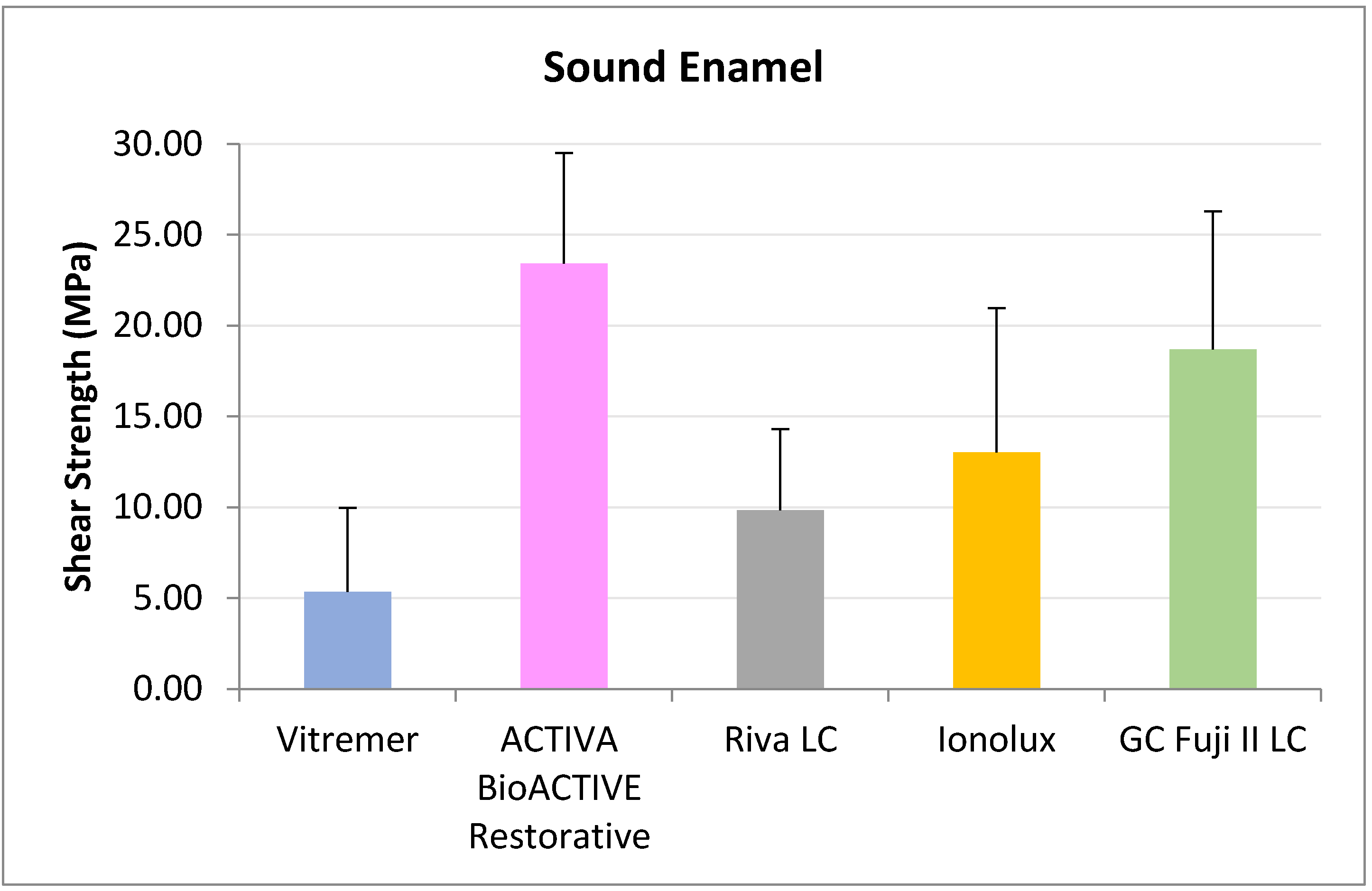

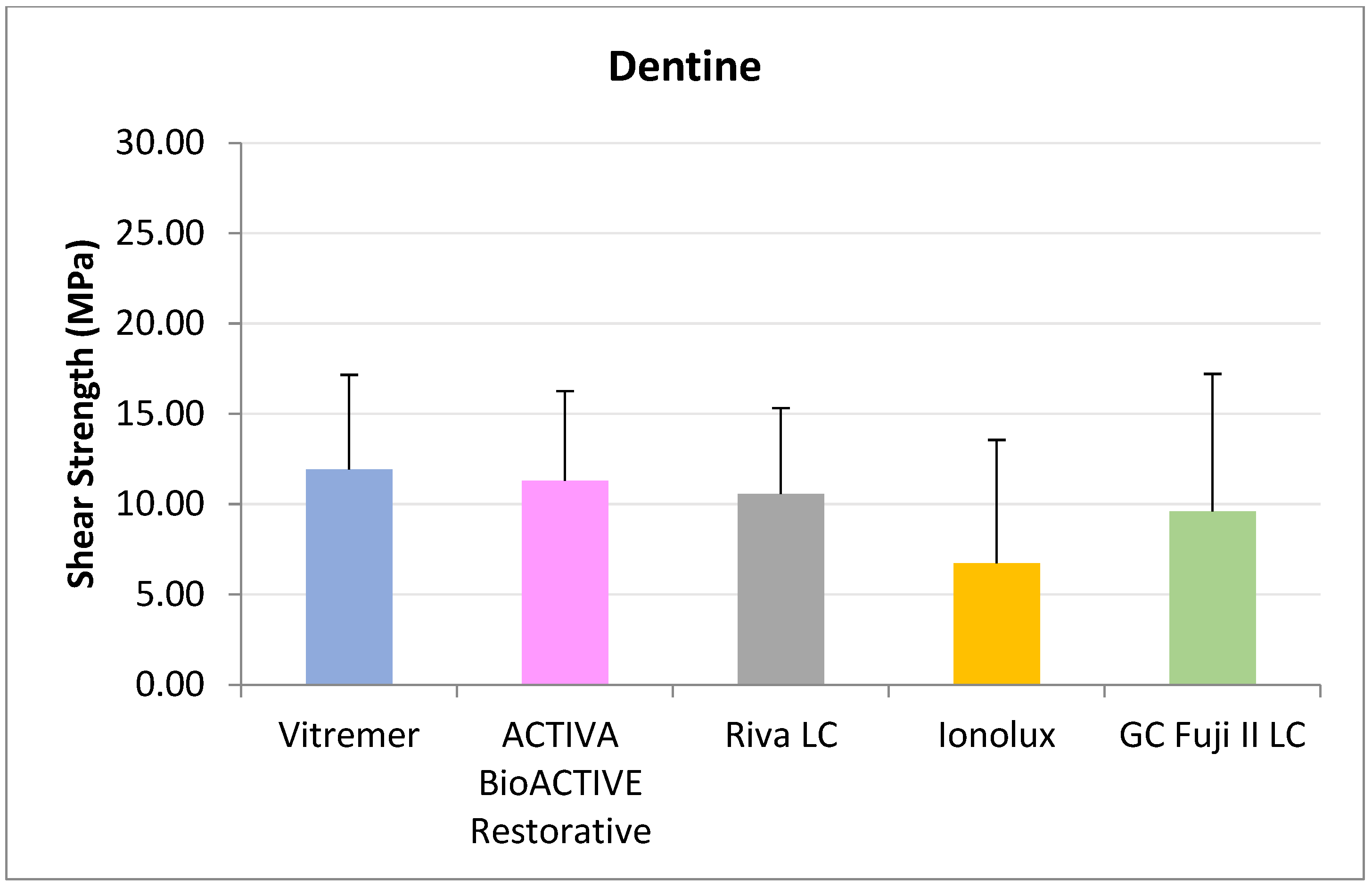
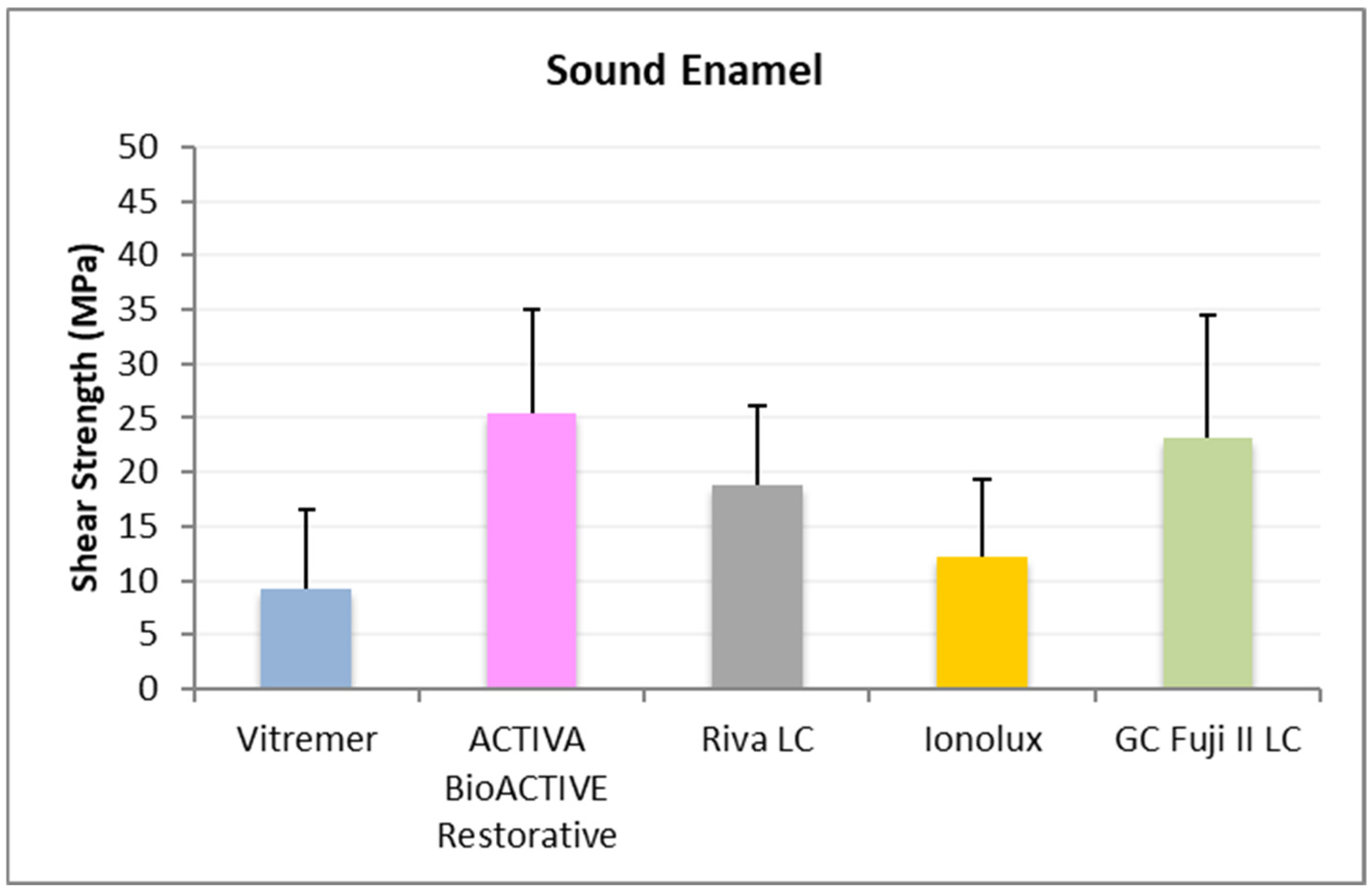
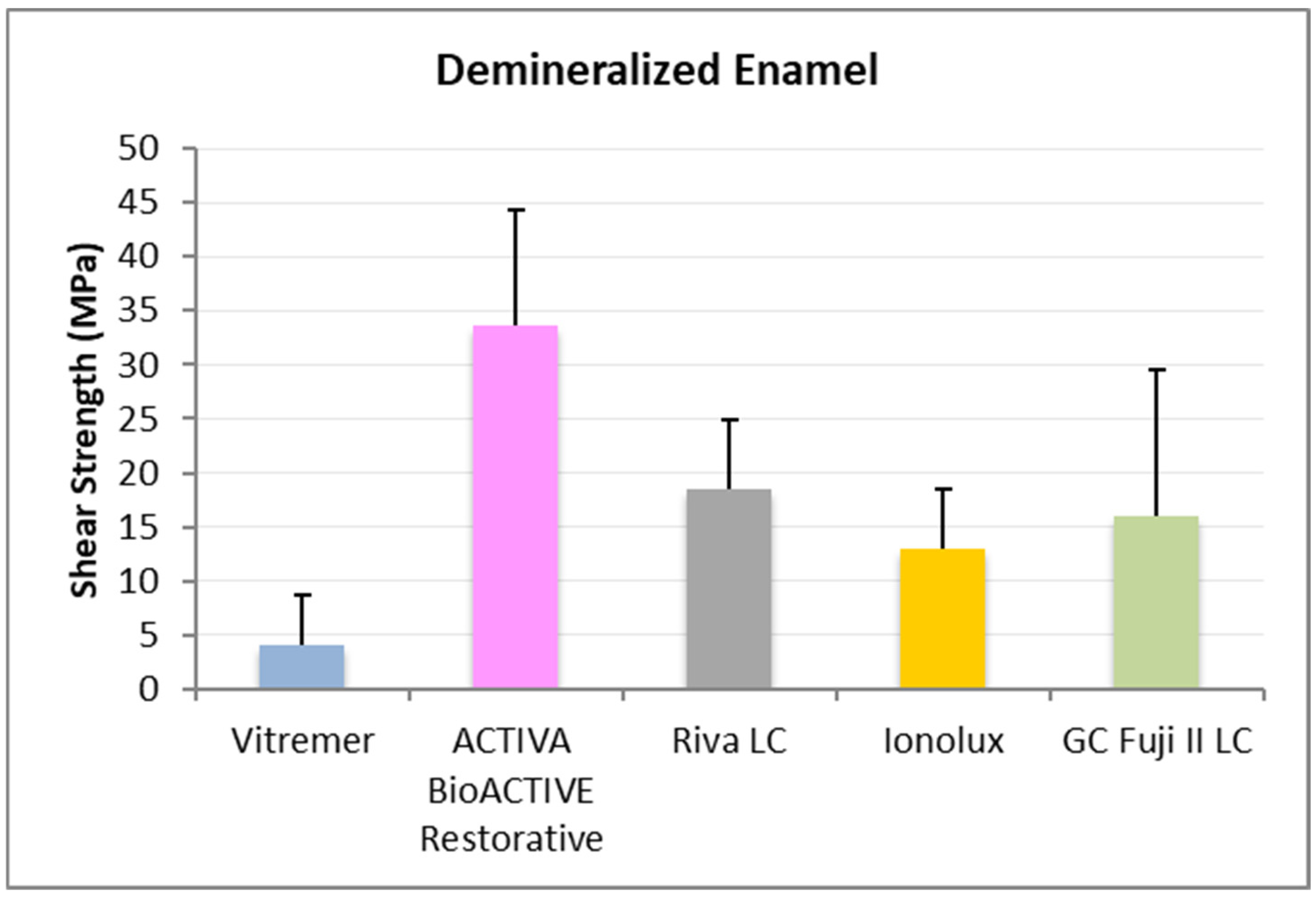

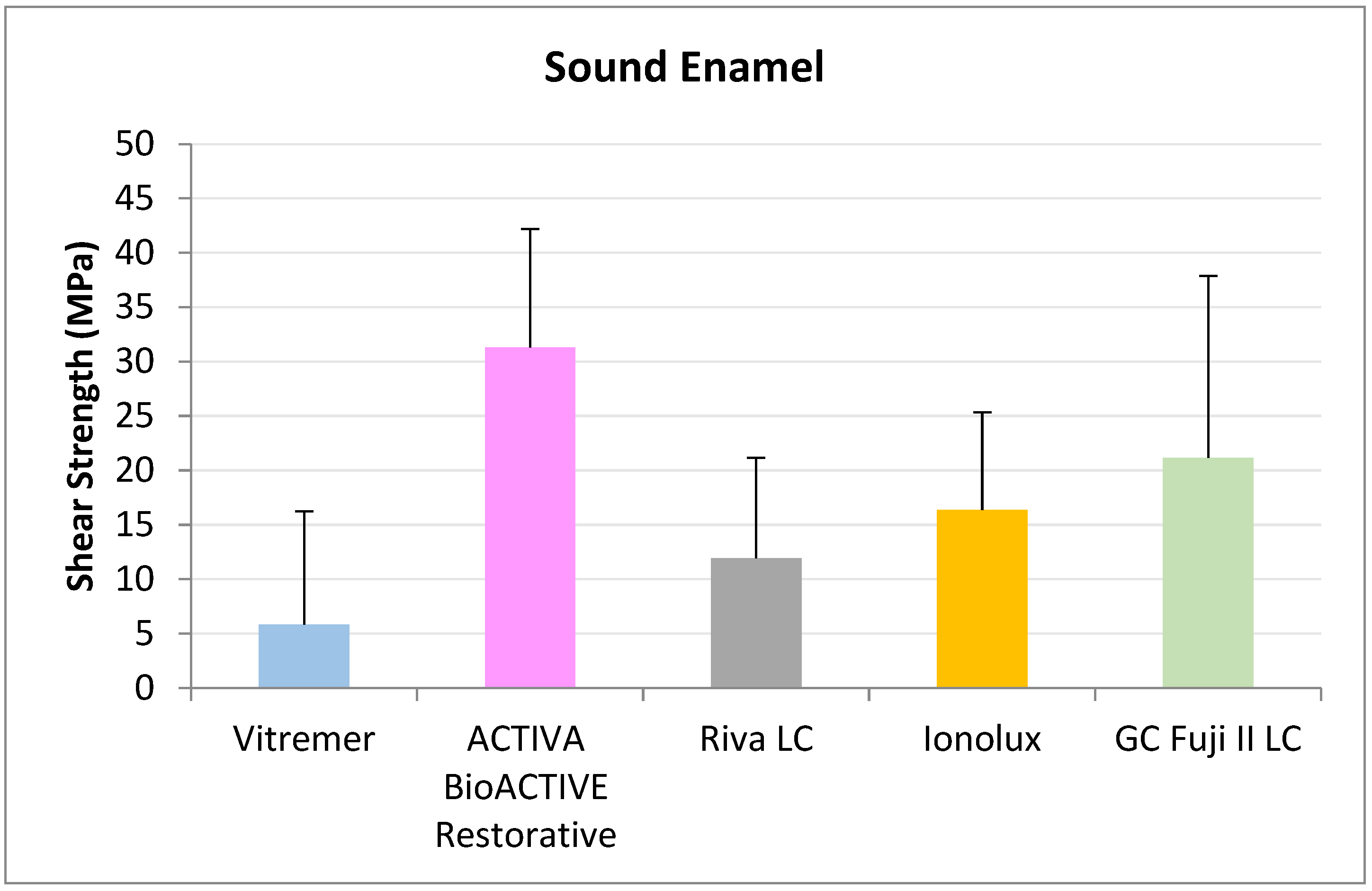




| Material | Time | Mean ± SD (ppm/g) | Median (ppm/g) |
|---|---|---|---|
| Vitremer® | 24 h | 213.17 ± 26.32 | 206.47 |
| 48 h | 293.08 ± 113.70 | 307.21 | |
| 7 d | 339.93 ± 81.03 | 360.54 | |
| 14 d | 611.10 ± 209.93 | 692.09 | |
| 30 d | 635.99 ± 305.38 | 758.50 | |
| ACTIVA BioACTIVE Restorative | 24 h | 10.94 ± 3.27 | 10.09 |
| 48 h | 13.80 ± 2.19 | 13.74 | |
| 7 d | 21.97 ± 1.18 | 21.80 | |
| 14 d | 29.26 ± 0.69 | 29.37 | |
| 30 d | 39.10 ± 2.16 | 39.74 | |
| Riva LC | 24 h | 43.92 ± 46.90 | 22.44 |
| 48 h | 67.37 ± 26.73 | 57.04 | |
| 7 d | 177.11 ± 16.84 | 184.27 | |
| 14 d | 224.13 ± 64.71 | 256.09 | |
| 30 d | 295.93 ± 27.12 | 310.33 | |
| Ionolux® | 24 h | 197.76 ± 23.58 | 203.49 |
| 48 h | 229.06 ± 86.35 | 252.11 | |
| 7 d | 315.41 ± 163.24 | 374.79 | |
| 14 d | 448.92 ± 50.48 | 461.65 | |
| 30 d | 501.21 ± 138.71 | 546.11 | |
| GC Fuji II LC® | 24 h | 82.32 ± 28.57 | 87.88 |
| 48 h | 115.85 ± 49.68 | 126.47 | |
| 7 d | 145.82 ± 41.12 | 167.71 | |
| 14 d | 191.60 ± 55.84 | 197.83 | |
| 30 d | 371.74 ± 61.18 | 399.78 |
| Material | Time | Mean ± SD (ppm/g) | Median (ppm/g) |
|---|---|---|---|
| Vitremer® | 24 h | 225.30 ± 26.28 | 223.37 |
| 48 h | 83.33 ± 20.72 | 80.78 | |
| 7 d | 135.05 ± 22.68 | 146.54 | |
| 14 d | 98.96 ± 10.58 | 96.79 | |
| 30 d | 130.20 ± 6.08 | 133.64 | |
| ACTIVA BioACTIVE Restorative | 24 h | 10.50 ± 0.85 | 10.26 |
| 48 h | 3.89 ± 1.78 | 3.17 | |
| 7 d | 8.17 ± 0.40 | 8.16 | |
| 14 d | 5.09 ± 0.35 | 5.11 | |
| 30 d | 7.84 ± 1.92 | 6.76 | |
| Riva LC | 24 h | 39.00 ± 33.37 | 23.97 |
| 48 h | 18.26 ± 15.36 | 10.73 | |
| 7 d | 72.53 ± 11.80 | 78.26 | |
| 14 d | 62.42 ± 2.57 | 63.70 | |
| 30 d | 68.29 ± 3.27 | 69.55 | |
| Ionolux® | 24 h | 207.59 ± 48.43 | 230.94 |
| 48 h | 154.08 ± 32.99 | 158.65 | |
| 7 d | 215.13 ± 42.14 | 232.57 | |
| 14 d | 181.24 ± 21.52 | 186.94 | |
| 30 d | 183.37 ± 19.71 | 183.56 | |
| GC Fuji II LC® | 24 h | 93.31 ± 16.59 | 93.09 |
| 48 h | 28.29 ± 6.88 | 28.31 | |
| 7 d | 60.98 ± 4.80 | 58.55 | |
| 14 d | 59.16 ± 3.21 | 60.72 | |
| 30 d | 82.95 ± 5.66 | 81.94 |
Disclaimer/Publisher’s Note: The statements, opinions and data contained in all publications are solely those of the individual author(s) and contributor(s) and not of MDPI and/or the editor(s). MDPI and/or the editor(s) disclaim responsibility for any injury to people or property resulting from any ideas, methods, instructions or products referred to in the content. |
© 2025 by the authors. Licensee MDPI, Basel, Switzerland. This article is an open access article distributed under the terms and conditions of the Creative Commons Attribution (CC BY) license (https://creativecommons.org/licenses/by/4.0/).
Share and Cite
Cereceda-Villaescusa, P.; Valverde-Rubio, P.; Cabello, I.; Pérez-Silva, A.; Martínez-Beneyto, Y.; Ríos, I.G.; Ortiz-Ruiz, A.J. Time-Dependent Adhesion and Fluoride Release of Resin-Modified Glass Ionomer Cements on Demineralized Enamel, Sound Enamel and Dentine. J. Clin. Med. 2025, 14, 7166. https://doi.org/10.3390/jcm14207166
Cereceda-Villaescusa P, Valverde-Rubio P, Cabello I, Pérez-Silva A, Martínez-Beneyto Y, Ríos IG, Ortiz-Ruiz AJ. Time-Dependent Adhesion and Fluoride Release of Resin-Modified Glass Ionomer Cements on Demineralized Enamel, Sound Enamel and Dentine. Journal of Clinical Medicine. 2025; 14(20):7166. https://doi.org/10.3390/jcm14207166
Chicago/Turabian StyleCereceda-Villaescusa, Pilar, Pilar Valverde-Rubio, Inmaculada Cabello, Amparo Pérez-Silva, Yolanda Martínez-Beneyto, Inmaculada Gómez Ríos, and Antonio José Ortiz-Ruiz. 2025. "Time-Dependent Adhesion and Fluoride Release of Resin-Modified Glass Ionomer Cements on Demineralized Enamel, Sound Enamel and Dentine" Journal of Clinical Medicine 14, no. 20: 7166. https://doi.org/10.3390/jcm14207166
APA StyleCereceda-Villaescusa, P., Valverde-Rubio, P., Cabello, I., Pérez-Silva, A., Martínez-Beneyto, Y., Ríos, I. G., & Ortiz-Ruiz, A. J. (2025). Time-Dependent Adhesion and Fluoride Release of Resin-Modified Glass Ionomer Cements on Demineralized Enamel, Sound Enamel and Dentine. Journal of Clinical Medicine, 14(20), 7166. https://doi.org/10.3390/jcm14207166







